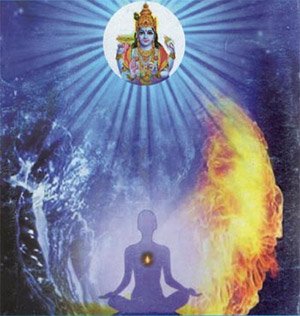Siddhanta Sangraha of Sri Sailacharya
by E. Sowmya Narayanan | 2008 | 30,562 words
Siddhanta Sangraha Chapter 41 (English translation), entitled “the equality and inequality among the categories” as included in the critical edition and study. The Siddhanta Samgraha is a Sanskrit philosophical text dealing with Vishishtadvaita in five hundred Sanskrit verses. It was written by Shri Shailacarya (18th century) and closely follows the philosophy of Vedanta Deshika (13th century).
Chapter 41 - The Equality and Inequality among the Categories
487. It has been stated by the Vedic Scholars that the aspect of possessing the saṃyoga and the aspect of śakti are the common attributes for all the substances.
488-489. Out of six substances the avyakta and kāla possesses the non-sentiousness (jaḍa-dravyatva) as its exclusive feature, which is Sādharmya of them. The other four, namely, jīva, Īśvara, dharmabhūtajñāna and nityavibhūti possesses ‘svayam prakāśatvam (self-luminosity)’ as their Sādharmya. This has been accepted by the Scriptures. It is well known fact that the ‘ātmatva’ is the Sādharmya for the above four.
490. The Sādharmya for dharmabhūtajñāna and nityavibhūti is the self luminosity, which is different from that of ātman (anātmatve sati svayam prakāśatvam).
491. The objects which are different from īśvara or the Supreme have ‘svataśśeṣatvam’ (innately subservient to the Supreme) as their Sādharmya. And it is accepted that the Sādharmya for the prakṛti and nitya vibhūti is explained as ‘sattvaguṇavattvam’.
492. The three types of cetanas (conscious beings) namely, Baddhas, Muktas and Nityas possess the Sādharmya as being sub-servient to the divine couple. Whereas, the Sādharmya for the Nityas and Muktas is nothing but the total bliss of the Supreme.
493. The similarity for the divine couple is their natural Lordship without any adventious condition (nirūpādhika śeṣitvam). The same natural Lordship is the Vaidharmya as it is not present in other objects except the divine couple.
Conclusion:
 This concludes The Equality and Inequality among the Categories according to Vishishtadvaita philosophy explained by Shri Shailacarya. This book follows the model of Vedanta Deshika although the Vishishta Advaita school was originally expounded by Shri Ramanuja. Vishishta-Advaita is one of the various sub-schools of Vedanta which itself represents one of the six orthodox schools of Hindu Philosophy. They highlight the importance of the Upanishads, the Bhagavad Gita and the Brahma Sutras.
This concludes The Equality and Inequality among the Categories according to Vishishtadvaita philosophy explained by Shri Shailacarya. This book follows the model of Vedanta Deshika although the Vishishta Advaita school was originally expounded by Shri Ramanuja. Vishishta-Advaita is one of the various sub-schools of Vedanta which itself represents one of the six orthodox schools of Hindu Philosophy. They highlight the importance of the Upanishads, the Bhagavad Gita and the Brahma Sutras.
